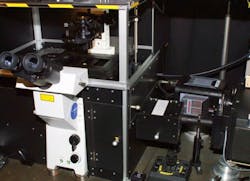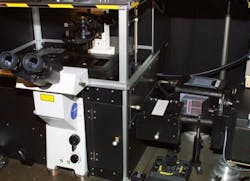Microspectroscopy setup can track singlet oxygen in individual cells
Researchers in the Optical Spectroscopy Group within the Department of Chemical Physics and Optics at Charles University (Prague, Czech Republic) have developed an experimental setup that enables direct microspectroscopic monitoring of singlet oxygen using a 2D-array indium gallium arsenide (InGaAs) camera with near-infrared (NIR) sensitivity.
Related: High-confidence, high-throughput screening with high-def IR microspectroscopy
Singlet oxygen, the first excited state of molecular oxygen, is a highly reactive species that plays an important role in a wide range of biological processes, including cell signaling, immune response, macromolecule degradation, and elimination of neoplastic tissue during photodynamic therapy (PDT). Often, a photosensitizing process is employed to produce singlet oxygen from ground-state oxygen.
The researchers used two detection channels (visible and NIR) to perform real-time imaging of the very weak NIR phosphorescence of singlet oxygen and photosensitizer simultaneously with visible fluorescence of the photosensitizer. Their experimental setup enables acquisition of spectral images based on singlet oxygen and photosensitizer luminescence from individual cells, where one dimension of the image is spatial and the other is spectral, covering a spectral range from 500 to 1700 nm.
To achieve these results, a 2D InGaAs camera was coupled to an imaging spectrograph. The 2D detection array in the camera led to a dramatic reduction of acquisition times and helped to avoid some of the problems caused by photobleaching. A back-illuminated, silicon CCD camera was used to detect visible light in the setup.
The researchers indicate that the introduction of spectral images for such studies addresses the issue of a potential spectral overlap of singlet oxygen phosphorescence with NIR-extended luminescence of the photosensitizer and provides a powerful tool for distinguishing and separating them, which can be applied to any photosensitizer manifesting NIR luminescence.
Full details of the work appear in the journal Photochemical & Photobiological Sciences; for more information, please visit http://dx.doi.org/10.1039/c4pp00121d.
-----
Don't miss Strategies in Biophotonics, a conference and exhibition dedicated to development and commercialization of bio-optics and biophotonics technologies!
Follow us on Twitter, 'like' us on Facebook, and join our group on LinkedIn
Subscribe now to BioOptics World magazine; it's free!

